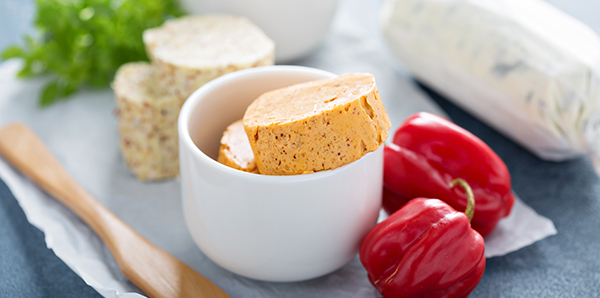Beyond Bare Butter: Mix-Ins Create Compounds That Impress
At the recent International Foodservice Editorial Council (IFEC) conference in Maine, a luncheon sponsored by Real California Butter and the California Milk Advisory Board included a breadbasket with a trio of butters: sweet/spicy gochujang, shallot compound butter and lemon caper blend. Butter, what’s happened to you? You used to be the pale, chilly accompaniment to our bread, often served in gleaming gold-paper rectangles. Now you’re a globe-trotting, risk-taking superstar, giving us glimpses of greatness as we slather you all over our dinner rolls (could someone pass the breadbasket, please?).
Many operators are including compound butters as a “next level” addition that unifies a menu and sets it apart from the ordinary. When served alongside an upscale breadbasket, compound butters can reflect overall menu themes and offer fresh new flavors in every bite. Of course, warm Sister Schubert’s® dinner rolls make a perfect complement for these of-the-moment slathers.
Robin and Martha (and lots of great butter)
Robin Selden is Managing Partner and Executive Chef of the company her mother founded, Marcia Selden Catering & Event Planning, based in Stamford, Connecticut. “Compound butters have been part of our offerings for quite a while,” she says. She recently supplied the recipes for an article in Martha Stewart Weddings, including Asian Nori, Sesame & Ginger Butter, Turmeric & Mustard Seed Butter, and Smoked Chipotle & Lime Butter. And her ideas keep coming: “Every time our kitchen staff finds a new flavor we like, we ask, ‘can we make a compound butter out of that?’”
New ideas
“Lately, we’ve been sautéing capers until they get crispy and pop. We blot them on a paper towel until dry, then mix them into butter with fresh dill,” Selden says. “It’s an intensely briny flavor that’s great on smoked salmon.” Savory choices aren’t her only focus, though. “One fruit butter I really love starts with cooked, mashed strawberries, strained, then added to butter. We drizzle in a balsamic glaze, but we don’t overmix, so you can still see those distinct lines of glaze, with the pink and the dark brown giving it a marbleized look.”
Prep tips
Once butters are mixed, they’re rolled in plastic wrap into logs and chilled. When it’s time for slicing, a hot, thin knife ensures the cleanest edge. “We create 1 ½-inch diameter coins, then stack one or two on individual bread plates, with a small plate of one or two extra slices for the table. It’s important never to stack them, because they’ll stick together or melt,” she says. That proviso brings about an irresistible image: rapidly melting compound butters, tempting diners to lick their plates clean, just to get the last of that buttery goodness.

